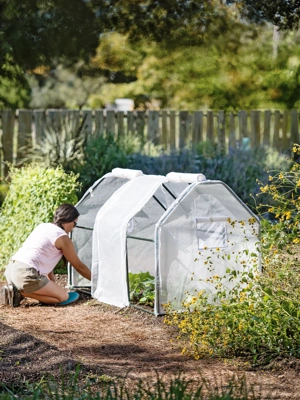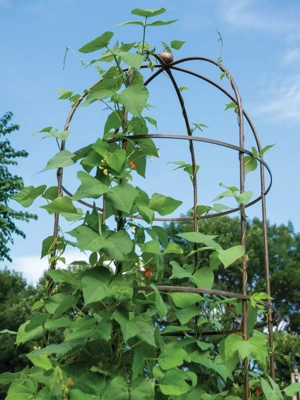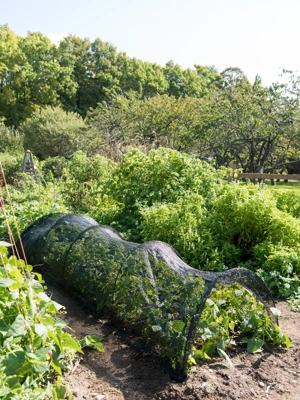How to Use Super Hoops
 Adjustable Super Hoops grow with your plants! When installed in a 4' wide bed, you can adjust the height with a thumb screw from 44" to 62" (highest point). Fabric not included.
Adjustable Super Hoops grow with your plants! When installed in a 4' wide bed, you can adjust the height with a thumb screw from 44" to 62" (highest point). Fabric not included.Super Hoops — it's a dramatic name for a simple product. But when you think of all the ways Super Hoops can help you in the garden, maybe that superhero name really does fit.
Unseasonal cold snaps, hungry flea beetles, nibbling cabbageworms, pounding rains, voracious potato beetles, searing sunshine, destructive vine borers, marauding birds, early fall frosts … considering all the challenges faced by gardeners, it's a wonder we manage to harvest anything at all! Incredibly, there is a simple, non-chemical way solution to these problems: Protect plants with the right kind of garden fabric (also known as row covers). And the easiest way to support garden fabric is with Super Hoops.

Hi-Rise Super Hoops, above, and Super Hoops, below, are made from two parallel, heavy-gauge wires joined by cross braces. The double-wire construction not only makes them more stable, it also provides better support than single-wire hoops.

Unlike single-wire hoops that tend to sway and flop, Super Hoops are made from two parallel, heavy-gauge wires joined by cross braces. The double-wire construction not only makes them more stable, it also provides better support for row covers than single hoops. Super Hoops come in two sizes: regular Super Hoops provide 14" of headroom in the center when installed across a 3-foot-wide bed. High-Rise Hoops provide 43" of headroom. Adjustable Super Hoops provide up to 62" of headroom in a 4' wide bed.
Assembly
The Super Hoops are already assembled, but if you have the Hi-Rise Super Hoops, take the following steps:
- Connect two flattened hoops with two of the included connectors, and bend it gently into an arch.
- Using the remaining pieces, continue until you have formed six large hoops.
Setting Up a Hoop Tunnel
- Position the first hoop in the garden and insert its legs into soil. The width or distance between the hoop legs can vary depending upon the height of your crops or the width of your bed. To use a 12-foot-wide piece of garden fabric or shade netting, the hoop legs should be no more than 5 feet apart.
- Position the next hoop approximately 2 feet from the first. Repeat this step for the rest of the hoops.
- Drape the fabric or netting over the hoops, using clothespins to anchor it. Be sure to leave at least 4" of extra fabric on either side of the tunnel so you can secure the edges with soil and/or Earth Staples. Pull the fabric taut on both ends, using Earth Staples to anchor it to the ground.
Super Hoops Through the Seasons
Simply set up the hoops in early spring, and attach the different types of garden fabric as you need them through the seasons:
- GardenQuilt Fabric provides frost and cold protection down to 24 degrees F. By covering beds with this extra-thick material you can start your early-season crops weeks ahead of time and protect early transplants from chilly, drying winds.
- All-Purpose Fabric provides frost protection down to 28 degrees F. More lightweight than the GardenQuilt Fabric, it's ideal for covering warm-season crops if a late frost threatens and for protecting transplants from pounding spring rains. In cool-weather areas, it can also be used as a summertime pest control.
- Summerweight Fabric is the best choice for season-long pest control. It allows a full 85% light transmission for healthy growth while effectively screening out insect pests, from tiny flea beetles to cabbage butterflies looking for a place to lay their eggs (which would quickly hatch into hungry cabbageworms), and everything in between. Because it's so lightweight, there's less heat build-up than with heavier fabrics.
- Bird Netting keeps pesky birds from devouring berries or pecking tomatoes. In just a few hours a flock of birds can strip your entire strawberry bed. And why do birds take a beakful or two out of every ripe tomato instead of just eating one? With Super Hoops you'll be prepared to cover plants before fruits ripen.
 Protect ripening fruit from hungry birds with Super Hoops and Bird Netting.
Protect ripening fruit from hungry birds with Super Hoops and Bird Netting.Finally, as summer progresses into fall, All-Purpose Fabric and Garden Quilt can again protect plants from the chill, extending the growing season into late fall and early winter.
Tips
- Wait for a relatively windless day to install and remove row covers.
- When using fabric to exclude pests, bury the edges of the fabric in the soil or use Earth Staples to anchor it.
- Monitor plants carefully. Insects that sneak in can reproduce quickly in the protected environment.
- When flowers begin to form, remove covers from insect-pollinated crops, such as squash and melons, so pollinators can do their work.
- You can help prevent the spread of some plant diseases by using row covers to exclude the insects that transmit them. Aphids, whiteflies and leaf hoppers can infect plants with viral diseases as they feed.
Last updated: 03/08/2024
Print this Article:
Related items
Get the Dirt
Stay up to date on new articles and advice. Please fill out the information below.

 All-Purpose Fabric
All-Purpose Fabric Earth Staples
Earth Staples










